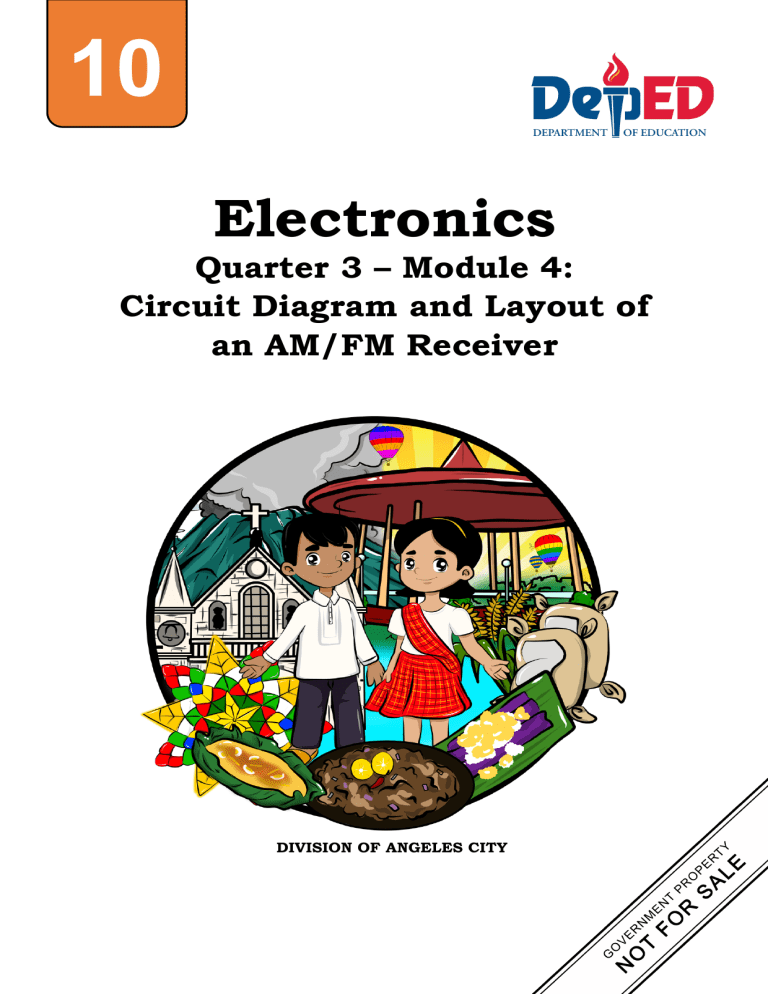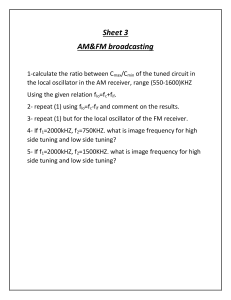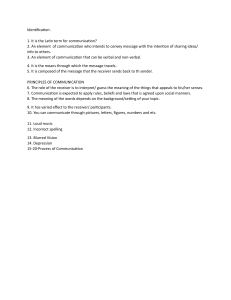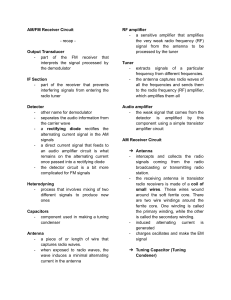
10 Electronics Quarter 3 – Module 4: Circuit Diagram and Layout of an AM/FM Receiver DIVISION OF ANGELES CITY Electronics– Grade 10 Alternative Delivery Mode Quarter 3 – Module 4: Circuit Diagram and Layout of an AM/FM receiver First Edition, 2021 Republic Act 8293, section 176 states that: No copyright shall subsist in any work of the Government of the Philippines. However, prior approval of the government agency or office wherein the work is created shall be necessary for exploitation of such work for a profit. Such agency or office may, among other things, impose as a condition the payment of royalties. Borrowed materials (i.e., songs, stories, poems, pictures, photos, brand names, trademarks, etc.) included in this module are owned by their respective copyright holders. Every effort has been exerted to locate and seek permission to use these materials from their respective copyright owners. The publisher and authors do not represent nor claim ownership over them. Published by the Department of Education Regional Director : May B. Eclar PhD, CESO V OIC Asst. Regional Director : Rhoda T. Razon EdD, CESO V Development Team of the Module Writers: Arnel C. Perez, Ferdinand J. Soriano, Mark Albert T. Pineda Editors: Marjorie D. Lacson, Nerissa N. Valdez, Eliza M. Roque Reviewers: Gemima A. Estrabillo, Emily F. Sarmiento, Hermes P. Vargas, Noel S. Reganit, Adrian P. Tamayo, Krislene Ida N. Mercado, Jonathan Carrasco, Billy Ray B. Manuel, Marvin R. Leano, Gemmarie G. Rivas Illustrator: Lady Diane M. Bonifacio Layout Artist: Lithos Sto. Domingo Management Team: May B. Eclar PhD, CESO V Rhoda T. Razon EdD, CESO V Ma. Irelyn P. Tamayo PhD, CESE Fernandina P. Otchengco PhD, CESE Librada M. Rubio PhD Ma. Editha R. Caparas EdD Emily F. Sarmiento, PhD Gemima A. Estrabillo, PhD Rochella C. David Printed in the Philippines by ___________________________ Department of Education – Region III- Division of Angeles CIty Office Address: Jesus St., Pulungbulu, Angeles City Telefax: (045) 322-5722; 322-4702; 888-0582; 887-6099 E-mail Address: angeles.city@deped.gov.ph 10 Electronics Quarter 3 – Module 4: Circuit Diagram and Layout of an AM/FM Receiver Introductory Message This Self-Learning Module (SLM) is prepared so that you, our dear learners, can continue your studies and learn while at home. Activities, questions, directions, exercises, and discussions are carefully stated for you to understand each lesson. Each SLM is composed of different parts. Each part shall guide you step-bystep as you discover and understand the lesson prepared for you. Pre-tests are provided to measure your prior knowledge on lessons in each SLM. This will tell you if you need to proceed on completing this module or if you need to ask your facilitator or your teacher’s assistance for better understanding of the lesson. At the end of each module, you need to answer the post-test to self-check your learning. Answer keys are provided for each activity and test. We trust that you will be honest in using these. In addition to the material in the main text, Notes to the Teacher are also provided to our facilitators and parents for strategies and reminders on how they can best help you on your home-based learning. Please use this module with care. Do not put unnecessary marks on any part of this SLM. Use a separate sheet of paper in answering the exercises and tests. And read the instructions carefully before performing each task. If you have any questions in using this SLM or any difficulty in answering the tasks in this module, do not hesitate to consult your teacher or facilitator. Thank you. What I Need to Know This module was designed and written with you in mind. It is here to help you master the circuit diagram and layout of an AM/FM receiver. The scope of this module permits it to be used in many different learning situations. The language used recognizes the diverse vocabulary level of students. The lessons are arranged to follow the standard sequence of the course. But the order in which you read them can be changed to correspond with the textbook you are now using. The module will cover the lesson: ● Lesson 4 – Circuit Diagram and Layout of an AM/FM receiver After going through this module, you are expected to: ● Interpret the diagram and layout of the components of an AM/FM receiver for accurate circuit assembly. 1 What I Know Direction: Choose the letter of the best answer. 1. What part of the FM receiver interprets the signal processed by the demodulator? a. Input transducer c. Photodiode b. Output transducer d. Transistor 2. What do you call the component made of two wires wound around the core? a. Antenna c. Transducer b. Oscillator d. Zener diode 3. What part of the receiver prevents interfering signals that enter the radio tuner? a. Antenna c. IF section b. Detector d. Mixer 4. What is the usual component found in the mixer? a. Antenna c. Photodiode b. Mirror d. Transistor 5. What component is usually involved in the IF section? a. Capacitors c. Resistors b. Detector d. Transformer 6. What is the other name of the demodulator? a. Capacitors b. Detector c. Resistors d. Transformer 7. What is the usual component found in the detector? a. Crystal Diode c. Transformer b. Lead Resistor d. Transistor 8. Which among the process involves the mixing of two different signals to produce new ones? a. Convolution c. Heterodyne b. Echo reaction d. Oscillation 9. What component is used in making a tuning condenser? a. Capacitors c. Resistors b. Detector d. Transformer 10. Which receiver’s component is used to intercept and collect radio signals? a. Antenna c. Mixer b. IF section d. Detector 2 Lesson 1 Circuit Diagram and Layout of an AM/FM Receiver Radio wave acts as a carrier of information-bearing signals, and the information may be encoded directly on the wave by periodically interrupting its transmission or impressed on it by the process of modulation. When the radio waves reach the receiving antenna, it induces electromotive force (emf) in it, which is very small in magnitude and feeds to the radio receiver. Here in figure 1, the radio waves that the antenna receives is amplified by the radio frequency (RF) amplifier, then the process of demodulation extracts signals from them. The signal amplifies by audio amplifiers and then feed to the speaker for reproduction into sound waves. Source: https://kids.britannica.com/students/assembly/view53880 Figure 1. Radio waves reception and conversion. 3 What’s In A radio receiver is the opposite of a radio transmitter. It uses an antenna to capture radio waves, processes those waves to extract only those waves that vibrate at the desired frequency, extracts the audio signals that add to those waves, amplifies the audio signals, and finally plays them on a speaker. There were different structures discussed in week 3 such as the tuner and audio detector. The table below shows the list of the parts involved in the reception of radio waves. To check the lessons that were taught last time, answer the table below by writing each part of a radio receiver’s function. Parts of a radio receiver Function Tuner Audio Detector Audio Amplifier Reproducer What’s New In the transistor radio receiver set that we have at home, the radio tuner is a section that intercepts and collects the radio signals coming from the radio broadcasting or transmitting station. There are two types of radio tuners. One is the amplitude modulation (AM) radio tuner, and the other is the frequency modulation (FM) radio. In amplitude modulation, the frequency of the signal is constant, but the amplitude or height of the signal varies. On the other hand, in the frequency modulation, the frequency of the signal varies, but the amplitude or height of the signal is constant. Activity 1. Guess What DIRECTION: Read the statement carefully and identify the correct answer. __________1. It intercepts and collects the radio signals coming from the radio broadcasting or transmitting radio stations. __________2. It selects which of the collected radio signals at the antenna should enter the radio tuner. 4 __________3. It prevents the signal from radiating to other circuits in the radio tuner. __________4. It mixes the signals coming from the antenna that tuned-in by the tuning capacitor and the signals that come from the local oscillator. __________5. This section of the radio tuner is like an electronic gate. __________6. It is also called the demodulator. Its work is to detect and recover the audio information from the radio signal received by the radio tuner. __________7. This is found in transistor radio receivers that are made up of a coil of small wires. __________8-9. These are two wires wind around the iron core. __________10. The part of the receiver that is also called as variable capacitor. What is It RADIO RECEIVER AM Radio Parts and Functions Antenna. The antenna’s function in the radio tuner is to intercept and collect the radio signals coming from the radio broadcasting or transmitting radio station. The antenna collects all the radio signals from the transmitting radio station. The receiving antenna in transistor radio receivers is made of a coil of small wires. These wires wound around the ferrite core. There are two wire windings around the ferrite core. One winding is called the primary winding, while the other is called the secondary winding. In figure 2, you will see the AM radio tuner Schematic Diagram. 5 Tuning Capacitor or Tuning Condenser. The tuning capacitor’s work is to select which of the collected radio signals at the antenna should enter the radio tuner. Only one radio signal should enter the radio tuner, and that radio signal is the one selected or tuned-in by the tuning capacitor. The tuning capacitor is composed of metal plates that are separated by the insulators. Tuning capacitors are also called variable capacitors. The capacitance or capacity of the tuning capacitor is varied or changed every time we turn its knob to select which radio signal from the radio station should enter the radio tuner; the plates of the adjustable tuning capacitor are called the rotor plates. The plates that are not adjustable is called the stator plates. Local Oscillator. The work of the local oscillator is to produce the oscillator signal. This signal is called a local oscillator signal. The local oscillator is in the radio receiver and is local to the radio receiver. There is also an oscillator in the radio transmitting station, and this is called radiofrequency (RF) or radio carrier frequency oscillator. The local oscillator is made of two small wires. These small wires are wound around the adjustable ferrite core. One wire winding is called the primary winding, and the other is called the secondary winding. The local oscillator is usually enclosed in a metal shield to prevent the local oscillator signal from radiating to other circuits in the radio tuner. To identify it, the top portion of the local oscillator is usually painted red color. Mixer-Converter Transistor. As the name implies, its function is to mix the signals coming from the antenna. It is tuned in by the tuning capacitor, and the signals come from the local oscillator. After mixing, these two signals are converted to new signals known as the intermediate frequency (IF signal). The standard frequency of the IF signals for amplitude modulation (AM) radio tuner is 455 kHz, (Kilohertz), or 455,000 Hertz, (Hz). These are the same for all AM radio tuners. The process of mixing two different signals to produce a new signal or signals is called the heterodyne process or heterodyning process. This process is used in all radio receivers, and that is why all radio receivers are often called superheterodyne radio receivers. Intermediate Frequency (IF) Section. The IF section of the radio tuner is like an electronic gate. When the 455 kHz IF signal arrives, it automatically opens to permit this 4bb kHz IF signal to pass through and enter the radio tuner. However, when other signals whose frequency is not 455 KHz attempts to enter, the IF section automatically blocks this signal. The IF section prevents interfering signals to enter the radio tuner when it is tuned to one radio station with this action. Typically, there are three intermediate frequency transformers (IFTs) used in the IF section. Between the second IFT and third IFT is the second IF amplifier transistor. However, although three IFTs were used and two IF amplifier transistors in the IF section, their functions are the same; they prevent interference. The basic construction of the IF transformers is the same. They are made of two small wires wound around the adjustable ferrite core and enclosed in a metal shield. The adjustable ferrite cores are adjusted during the aligning process of the radio tuner. 6 Detector. The detector is also called the demodulator. Its work is to detect and recover the audio information from the radio signal received by the radio tuner. The radio signal that comes from the radio station contains the audio information or audio signal. This audio information is the equivalent of the radio announcer’s voice or the voices that comes from the record being played at the radio station. When the receiving antenna receives the radio signal, it contains this audio information, and it is the detector that detects and recovers this audio information. The separated and recovered audio information or signal is then fed to the audio amplifier where it is amplified or strengthened sufficiently; the detector is usually made of a small crystal diode. Below is the pictorial diagram of the receiver and its components. Figure 3. Pictorial diagram of a radio receiver circuit and components How the Radio Signal Flows in the Radio Tuner We have seen the pre-emphasis network (High pass filter), which is present before the FM modulator. It is used to improve the SNR of high-frequency audio signals. Thus, in this FM receiver, the de-emphasis network (Low pass filter) is included after the FM demodulator. This signal is passed to the audio amplifier to increase the power level. Finally, we get the original sound signal from the loudspeaker. Below is the block diagram of the FM signal receiver to overcome these drawbacks. Image Source: https://circuitdiagramimages.blogspot.com/2019/02/fm-transmitterand-receiver-block.html Figure 4. Block diagram of a FM signal receiver 7 What’s More Activity 2: NAME THAT SYMBOLS Direction: Identify each electronic symbol found in AM Radio Receiver’s schematic diagram by writing the names and the value of the components. Example. Answer-Resistor 1,000,000 ohms Example 1 2 3 625mW http://whatis-electronics.blogspot.com/2010/08/fm-radio-reciever.html 4 5 Component Value 1. 2. 3. 4. 5. Assessment 2: 1. Where do you think the reception of radio waves start in the diagram? List down the components involved. 2. How do L2-2.2µH, TR2, R3-1M, and C3-10nF work in the radio receiver system? 8 Activity 3: Stop, Think and Write Direction: Write your insights on the importance of the circuit component in a FM receiver through creative writing. A minimum of one hundred words and a maximum of one hundred fifty words can be applied in this activity. Features Quality of Writing Grammar, Usage & Mechanics 4 Expert The piece was written in an extraordinary style and voice. Very informative and wellorganized There were spelling, punctuation, or grammatical errors. 3 Accomplished The piece was written in an interesting style and voice. Somewhat informative and organized There were few spelling and punctuation errors, minor grammatical errors. 2 Capable The piece had little style or voice. Gives some new information but poorly organized A number of spelling, punctuation or grammatical errors. 1 Beginner The piece had no style or voice. Gives no new information and very poorly organized There were many spelling, punctuation, and grammatical errors that interfere with the meaning. Activity 4: Go with the flow Direction: Fill out the missing parts of the FM radio receiver block diagram. Assessment 4: 1. What is the role of the local oscillator in the block diagram? 2. How does the radio signal received by the antenna convert into sound in the loudspeaker? 9 What I Have Learned Direction: Let us summarize your insights by searching the words on the word pool below. WORD POOL Guide Questions: 1. How do you describe the process of signal reception in the demodulator? 2. How do you describe the function of a transistor in the AM/FM receiver? Rubric 1 point 2 points 3 points 4 points 5 points Answer is completely incorrect, and no support is provided Answer is correct but there is no support, OR the answer is incorrect but there is some correct support Answer is correct and there is some support Answer is correct and support needs continuity Answer is correct and the support is fully developed 10 What I Can Do Direction: Complete the sentences by putting the correct word/s from the box. Primary and secondary Mixer-converter transistor Ferrite core Metal plates Intercept and collect Audio amplifier Capacitance RF Signal FM receiver Heterodyning 1. The ______________ of the tuning capacitor is varied or changed every time we turn its knob to select which radio signal from the radio station should enter the radio tuner. 2. Sensitivity is the capacity to detect an ____________ and demodulate it while at the lowest power level. 3. The antenna’s function in the radio tuner is to _________________the radio signals coming from the radio broadcasting or transmitting radio station. 4. The IF transformers are made of two small wires wound around the adjustable _____________ and enclosed in a metal shield. 5. The _____________ is the whole unit that takes the modulated signal as input and produces the original audio signal as an output. 6. A _______________________mixes the signals coming from the antenna. 7. A local oscillator is made from two wire winding which are called the _______________________winding. 8. The process of mixing two different signals to produce a new signal or signals is called the _____________. 9. The separated and recovered audio information generated by the detector is then fed to the _____________ where it is amplified or strengthened sufficiently. 10. The tuning capacitor is composed of ______________that are separated by the insulators. 11 Assessment Direction: Multiple Choice. Encircle the letter of the best answer. 1. Which among the following best describes a tuning capacitor? a. It selects the radio signals that should enter the radio tuner. b. It has two wire windings around the ferrite core. c. It mixes the signals coming from the antenna. d. It produces the oscillating signal. 2. Which device in a signal receiver separates the audio information from the received radio signals? a. Capacitors c. Resistors b. Detector d. Transformer 3. What is the standard frequency of the IF signals in an AM radio tuner? a. 45 Hz c. 455 kHz b. 455 Hz d. 455 MHz 4. What is the main structure of an IF transformer? a. Wire wound around a soft iron core b. An N and P type semiconductor c. Two N-Type semiconductors d. A single solenoid 5. What is found in between the separated conducting plate of a tuning capacitor? a. Charges c. Metals b. Insulators d. Radio waves 6. How does the IF transistor function in the receiver? a. They prevent signal interference b. The allow the signal to pass c. They filter radio waves d. All of the above 7. What is the other term used for tuning capacitor? a. Fixed capacitor c. Polar capacitor b. Lead capacitor d. Variable capacitor 8. Which receiver component usually strengthens the signal that is recovered? a. Amplifier c. Detector b. Capacitor d. Diode 9. What is produced in the local oscillator in the radio transmitting station? a. Electric surge c. Linear wave b. Interference d. Radio Frequency 10. What do you call the capacity of detecting an RF signal and demodulating it? a. Sensitivity c. Separability b. Selectivity d. Saturability 12 Additional Activity Direction: Write the correct name of each picture. 1. 2. 3. 4. 5. 13 What I Know 1. c 6. c 2. a 7. d 3. a 8. c 4. d 9. d 5. d 10. c What's New Act ivity 1 1. Antenna 2. Tuner 3. Local Oscillator 4. Mixer-Converter Transistor 5. Intermediate Frequency 6. Detector 7. Antenna 8. Primary Winding 9. Secondary Winding 10. Tuning Capacitor What’s More Act ivity 4 1. RF amplifier 2. Mixer 3. Limiter 4. De-emphasis Network 5. AF and power amplifiers Assessment 4: 1. It produces oscillating signal that is local to the receiver and prevents radiating signal to other circuit of the receiver. 2. The signal that is received by the antenna is processed by the demodulator which extracts the message then processed by the amplifier to make the signal stronger that is converted to sound. Assessment 1. a 2. b 3. c 4. a 5. b 6. a 7. d 8. a 9. d 10. a 14 What’s In Answer are found in module 3 What’s More Act ivity 2 1. Resistor-10k Ohms 2. Resistor-4.7k Ohms 3. Capacitor-100 microfarad 4. Inductor-2.2 microhenry 5. Transistor Assessment 2 1.It starts in L1 by using the VC1 and VC2 to be processed by TR1 2. L2-2.2µHit acts as an antenna that receives the signal while the TR2 serves as an amplifier. The R3-1M impedes flow of current while the C3-10nF stores energy that is released in the circuit. Act ivity 3 Answer may vary What I have Learned Answer may vary What can I do? 1. Capacitance 2. RF Signal 3. Intercept and collect 4. Ferrite core 5. FM receiver 6. Mixer-converter transistor 7. Primary and secondary 8. Heterodyning 9. Audio amplifier 10. Metal plates Additional Activity 1. Antenna 2. Tuning Capacitor 3. Diode 4. Local Oscillator 5. Mixer-Converter transistor Answer Key References AM/FM Radio system December 25, 2020 https://tinyurl.com/yywxsxof DIY FM Receiver, Accessed December 25, 2020 https://tinyurl.com/y5ks2wpk How does a radio work? December 25, 2020 https://tinyurl.com/y7zemz3e Radio FM receiver, Accessed December 24, 2020. https://tinyurl.com/y47trwhg Radio AM receiver, Accessed December 24, 2020. https://tinyurl.com/yxzfykht 15 For inquiries or feedback, please write or call: Department of Education – Region III- Schools Division of Angeles City Jesus St., Pulungbulu, Angeles City, Pampanga, Philippines 2009 Telefax: (045) 322-5722; 322-4702; 888-0582; 887-6099 Email Address: angeles.city@deped.gov.ph



